Why Intelligent Document Processing Is the Smartest Investment for Document-Heavy Industries

For sectors buried under PDFs, scans, and compliance paperwork, traditional automation no longer keeps pace. A recent study shows the average enterprise still spends over 52 % of staff time on manual document tasks, which directly impacts productivity, accuracy, and growth. Intelligent Document Processing (IDP) offers a way out.
Unlike legacy OCR (optical character recognition) or rigid rules, IDP blends AI, machine learning, and natural language processing to read, classify, and extract data from any document, structured or unstructured. Finance teams clear loan packets in hours instead of days, insurers process claims without re‑keying, and healthcare providers feed clean data straight into EHRs (electronic health records).
In this guide, the experts at our AI software development company break down intelligent document processing, covering what it is, how it functions, and why many modern leaders consider it essential for scalable automation. You’ll find real‑world IDP use cases, a technology deep dive, and practical steps for choosing IDP software or launching your first implementation.
What is intelligent document processing?
An intelligent document processing definition starts with this: IDP is an AI‑driven method for turning different types of documents into structured, actionable data. It handles scanned files, semi‑structured forms, and unstructured content such as contracts or free‑text emails, the inputs that traditional automation struggles to manage.
What sets IDP apart goes beyond simple text recognition. The system understands context, identifies document types, extracts critical fields, and routes data to the right destination. It adapts on the fly, so rigid templates and constant reconfiguration are unnecessary.
Unlike conventional automated document processing, which depends on static rules and unstable formats, IDP learns from every document it sees. Over time, accuracy improves, even when edge cases appear.
The technologies behind IDP
Modern IDP platforms unite multiple AI components into one streamlined system that handles documents and processes data at scale with precision and speed:
- OCR (Optical Character Recognition) detects text in scans, photos, or faxes, turning images into machine‑readable characters.
- Natural Language Processing (NLP) interprets sentence structure and context, letting the system pull entities, run smart searches, or build automatic summaries.
- Machine Learning (ML) classifies documents, detects anomalies, and adapts to new layouts. Gartner expects that by 2025, over half of IDP platforms will use advanced ML, increasing accuracy beyond 98 %.
- Robotic Process Automation (RPA) transfers extracted data into ERPs (enterprise resource planning), CRMs (customer relationship management), or custom systems. According to Automation Anywhere, IDP solutions built with native RPA launch five to ten times faster than those with disconnected tools.
Together, these technologies allow one IDP system to handle hundreds of documents per hour with near-human accuracy and no manual input. This capability matters most in sectors with continuous document flow. For many organizations, IDP also supports the broader AI implementation process, helping scale automation across departments and workflows.
How intelligent document processing works
Intelligent document processing turns a stack of mixed‑format files into clean, structured data through a clear, four‑step pipeline. The flow below shows how automated document processing moves from collecting raw files to turning them into usable data.
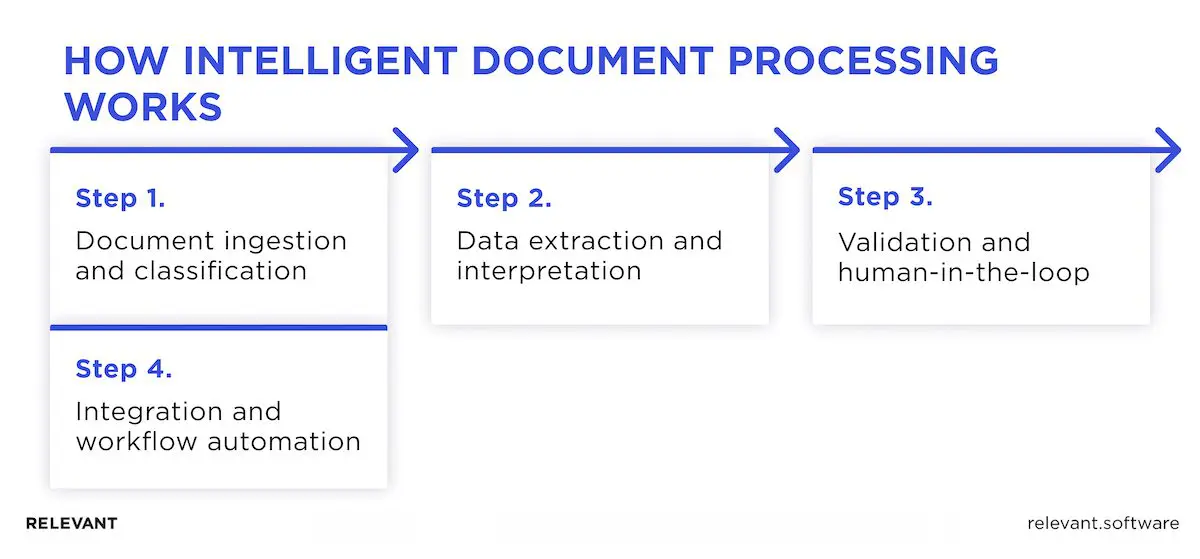
Step 1: Document ingestion and classification
The process begins when IDP pulls documents from one or more sources. These may include email attachments, scanned files, cloud storage, or direct uploads from enterprise systems. IDP tools can handle large amounts of documents quickly, no matter where they come from or what format they’re in.
Once the system captures the documents, it classifies them automatically. Machine‑learning models recognize layout patterns, language markers, and metadata to identify document types. Claims forms, tax records, and shipment invoices are automatically sorted into the right categories without human involvement. This step prepares the data for accurate field extraction later on.
Step 2: Data extraction and interpretation
After classification, the system moves to content extraction. OCR identifies all visible text and symbols on the page. Yet intelligent document processing applications do more than pull characters from a scan. NLP engines interpret context, while ML models locate names, dates, totals, or IDs, even in messy or poorly formatted layouts.
Step 3: Validation and human‑in‑the‑loop
Some documents never meet expectations. An IDP system helps catch unusual or incorrect data by checking the extracted information against business rules and data patterns. It gives each field a confidence score and flags anything that seems uncertain or doesn’t meet the required level.
Flagged data then moves to a reviewer. This human‑in‑the‑loop stage corrects low‑confidence fields without slowing the overall workflow. Once verified, clean data returns to the pipeline and flows downstream without interruption.
Step 4: Integration and workflow automation
The final step pushes validated data into operational systems like CRMs, ERPs, warehouse platforms, or custom dashboards. IDP connects through APIs or uses RPA to deliver results to the right endpoint.
The loop closes here. Data no longer waits in document form; it moves directly into workflows where teams act on it immediately. Faster access leads to better response times, cleaner records, and more reliable operations across finance, healthcare, insurance, and logistics.
Real-world use cases for intelligent document processing
Intelligent document processing plays a key role in today’s shift toward digital transformation. It replaces manual tasks and transforms paper records into usable data. With IDP, teams extract, verify, and direct information with greater speed and precision.
The examples below highlight how various industries turn large volumes of documents into insights, cut operational costs, and free teams from routine work.
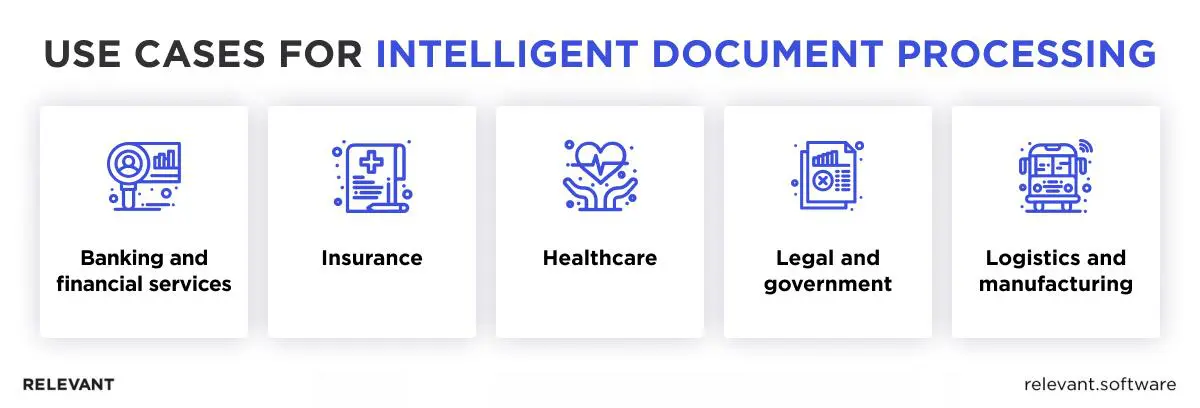
Banking and Financial Services
IDP use cases in banking cover every stage of customer onboarding and loan service. Banks, lenders, and fintechs process large volumes of documents such as KYC files, mortgage packets, and regulatory forms. KYC (Know Your Customer) refers to identity verification and risk assessment procedures required by law.
To manage this workload, financial institutions use IDP to:
- Loan application intake: capture and sort income statements, IDs, and tax documents
- Mortgage underwriting: pull key figures from property records, appraisals, and disclosures
- Account setup: confirm identities and review document sets
- KYC / AML compliance: detect anomalies before data enters core ledgers
Gartner reports that automating invoice and reconciliation tasks with IDP saves a 40-person finance team about 25,000 hours per year, which equals roughly $878,000 in labor costs. For broader insights, explore our guide “Conversational AI in banking”.
Insurance
Carriers rely on speed and precision to manage claims and policy updates. Key intelligent document processing applications in insurance include:
- Claims submission: read handwritten forms and scan attachments
- Policy renewals: extract dates, terms, and coverage details instantly
- Customer onboarding: apply data to underwriting rules with no manual input
- Fraud detection: compare new entries with historical records
Relevant Software analysts expect that by 2025, half of all B2B invoices will pass through fully automated systems. Claims workflows continue to follow the same path.
Healthcare
Hospitals and clinics must handle large volumes of medical documents with speed and precision. Intelligent document processing supports core operations and highlights the benefits of using AI in healthcare, including:
- Patient intake: extract names, contact details, and medical history
- Billing: assign accurate CPT or ICD codes with minimal error
- EHR updates: move scanned notes into clinical systems without delay
- Audit preparation: organise documents for HIPAA, GDPR, and insurance reviews
IDP reduces manual effort, cuts errors, and returns valuable time to medical teams. We build AI-powered document systems for healthcare providers, where precision, speed, and compliance must go hand in hand.
Legal and government
Legal teams and government agencies handle contracts, case files, and filings that often span hundreds of pages. Intelligent document processing supports key use cases within business process automation and management:
- Contract analysis: detect clauses, deadlines, and obligations to accelerate legal response
- Court records: extract parties, dates, and docket metadata to speed up case tracking
- FOIA requests: locate and redact sensitive content across large archives
- Regulatory filings: verify structure and required fields before official submission
These legal and government intelligence document processing use cases help teams reduce manual effort, ensure compliance, and keep audit trails in place while improving access and transparency.
Logistics and manufacturing
Supply chains depend on accurate, timely documentation. Intelligent document management supports critical workflows such as:
- Shipping documents: convert bills of lading, customs forms, and packing lists into structured data
- Quality inspections: capture information from checklists and handwritten reports
- Order confirmations: verify quantities, dates, and delivery terms
- Inventory reconciliation: align receipts with actual stock movement
Automated document flow at key points in the chain improves visibility, reduces cycle times, and protects margins across operations.
Your next read: Examples of AI in logistics
Benefits of implementing IDP technology
After exploring how technology works and where it brings the most value, let’s now summarise the core benefits of intelligent document processing that make it a strategic investment:
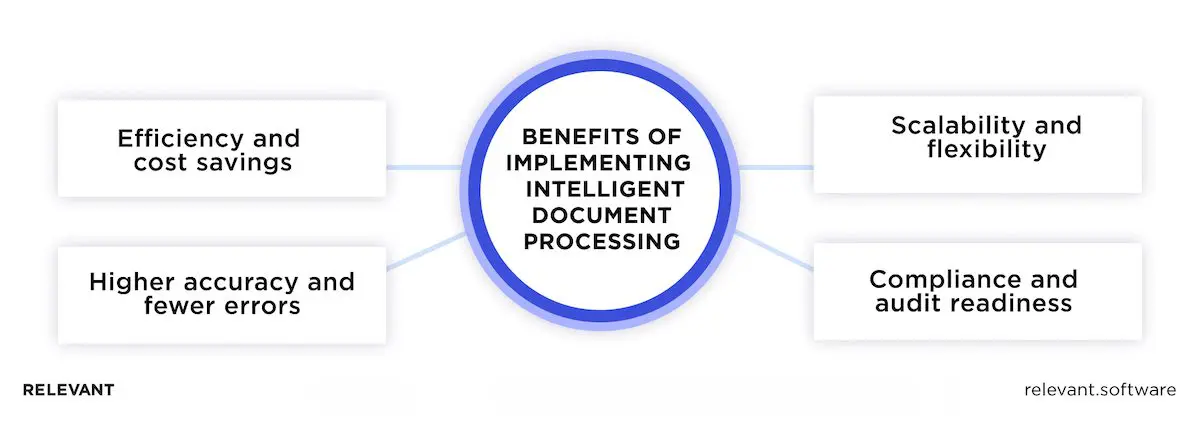
Efficiency and cost savings
Manual document tasks, such as invoice data entry, place a heavy burden on teams and create avoidable delays. Intelligent document processing removes these inefficiencies by automating data capture at scale. This shift improves accuracy, shortens processing time, reduces operational costs, and allows staff to focus on higher-impact work.
Higher accuracy and fewer errors
Older methods, such as traditional OCR, often misread various document types and cause frequent errors. Modern IDP systems rely on artificial intelligence and deep learning to identify and extract information from complex files with high accuracy. With rates above 99%, error levels drop sharply, and most documents pass through workflows without manual checks. This improves data validation and removes the need for constant human oversight.
Scalability and flexibility
IDP solutions scale from thousands to millions of documents each month without retraining or manual adjustments. The technology adapts to paper records, digital files, handwritten forms, and other inputs with no added effort. This removes repetitive tasks found in older document automation tools. Cloud-based IDP also gives companies the capacity to handle large data volumes, even during peak periods.
Compliance and audit readiness
Regulated industries benefit from the full audit trail built into IDP automation. Every extraction step, rule check, and user action is time‑stamped, encrypted, and controlled by role‑based permissions, which help organisations meet HIPAA, GDPR, and AML requirements with less effort.
Together, these advantages explain why companies across various industries rely on intelligent document processing as a critical part of their digital transformation efforts.
Challenges and limitations of IDP
Intelligent document processing brings clear value, but no system solves every problem. Some documents arrive in poor condition, which makes them unreadable even for advanced tools. In other cases, businesses must store data on-site to meet strict security or compliance rules. To ensure strong results, teams must focus on three essentials: data protection, document quality, and access to high-quality training data.
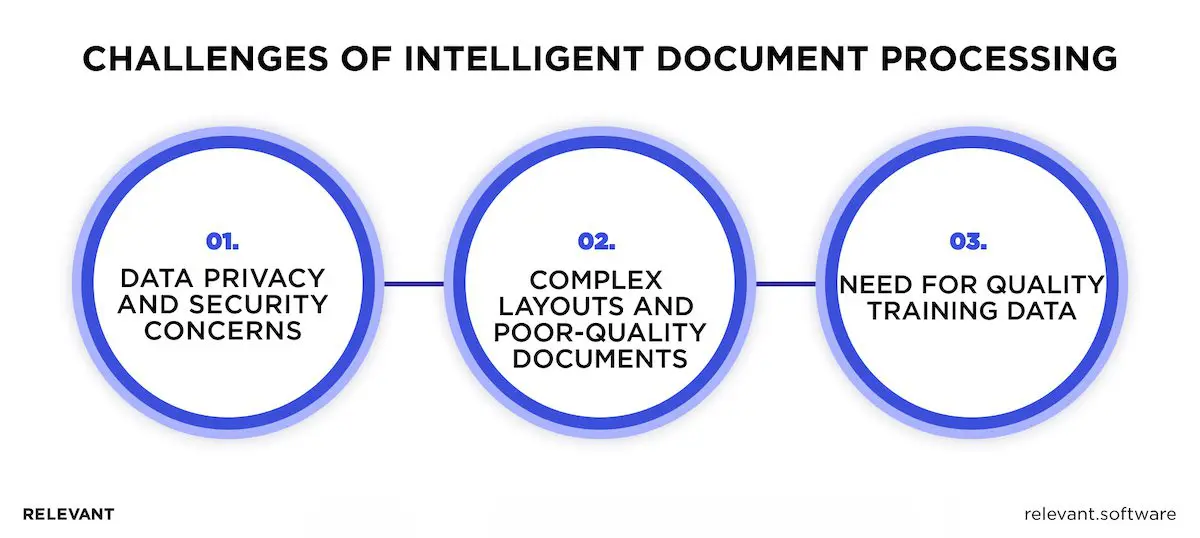
Data privacy and security concerns
Many intelligent document processing software platforms run in the cloud, which raises concerns about where sensitive data goes and how it’s handled. Things like medical records, bank statements, or legal files need more than speed. They need full security and control.
To protect this data, strong encryption, user permissions, and options to run the system on-site or in a private cloud help reduce risk. A mix of both, called a hybrid model, often works best. It keeps important data safe while still using cloud tools to handle large volumes.
Comment from Relevant Software experts: “Security always comes first, especially in fields like healthcare and finance. We build systems that protect data at every step, so Relevant Software clients can trust both the AI and the platform behind it.”
Complex layouts and poor‑quality documents
Blurry scans, crooked pages, and handwritten notes often confuse older OCR tools. Modern IDP systems fix many of these problems through image cleanup, smart layout detection, and backup rules. Still, results depend on how messy the documents are and how well the system prepares them.
Comment from Relevant Software experts: “Poor-quality documents are still a challenge. Smart processing and adaptive tools help, but no technology can read details the camera didn’t clearly capture.”
Need for quality training data
AI learns from examples. To work well, an IDP engine needs many real documents labeled clearly. These samples should cover different formats, languages, and unusual cases. Collecting and labeling documents takes effort and experience, especially in regulated industries.
Without good examples, the AI will make more mistakes, and people will have to step in often. Regular feedback and training help keep the system accurate.
Comment from Relevant Software AI engineers: “Great results depend on clear, high-quality data. We help clients collect and label documents from the start, so the AI model delivers accurate results right away and continues to improve.”
Getting started with IDP
Intelligent document processing delivers value only when it solves a real workflow need. A clear plan, based on business goals, document conditions, and technical limits, sets the stage for a successful rollout.
Questions to ask before implementation
Before choosing an intelligent document processing platform, confirm that the project aligns with real needs, not just new technology. Use the checklist below to frame that discussion:
- Document types: invoices, loan packets, treatment notes, shipping manifests?
- Volume: a few hundred files a day or tens of thousands per hour?
- Manual pain points: Where does manual data entry slow the current business process?
- Critical tasks: Data extraction, document classification, or full workflow automation?
- Target systems: ERP, CRM, content management, or custom databases?
Pilot project or full rollout?
The safest way to start is with a small test (pilot). Pick one task you handle often, such as invoices, claims, or document reviews. A pilot lets you see how the technology manages your real documents under real conditions. If the results are good, you can slowly expand until your entire process uses intelligent document processing.
Comment from Relevant Software experts: “A pilot isn’t just testing, it’s a growth plan. Our most successful clients always begin this way.”
Partnering with an IDP consultant or vendor
Choosing an intelligent document processing partner requires more than a feature comparison. The right team should:
- Understand your documents and industry requirements
- Prepare a well-labeled training set before model deployment
- Offer clear performance metrics and a defined error management plan
- Connect securely with your ERP, CRM, or internal systems
- Stay active after launch to adjust, expand, and support adoption
For companies without deep in-house AI expertise, outsourcing AI development often unlocks faster results, lowers risk, and strengthens control over compliance. But success doesn’t just depend on the provider. It requires a partner who understands the business context behind the model.
That’s why clients turn to us. At Relevant Software, we support the entire process from defining the project to launching it. We build reliable data pipelines, train AI models using real documents, and ensure a smooth transition into production. Our proven results in pharma and fintech speak for themselves, reflected in our 5-star Clutch rating for AI and ML consulting.
One of our most impactful collaborations shows what happens when the right AI strategy meets a complex, real-world challenge.

AstraZeneca: from unstructured data to actionable insight
AstraZeneca’s Medical Affairs teams were dealing with a growing amount of unstructured data, such as trial protocols, meeting notes, and reports. This made it difficult to work efficiently and slowed down access to important insights.
To address this, AstraZeneca partnered with our team to develop an AI-enabled platform capable of converting dispersed content into structured, compliant reports. The solution ingests three primary data sources: clinical documentation, real-world evidence, and liaison-generated notes. It systematically transforms them into clear, audit-ready summaries aligned with HIPAA and GDPR standards.
The platform runs on Google Cloud and incorporates advanced language models, including ChatGPT and Llama-2, to enable secure, real-time processing and global collaboration across medical teams.
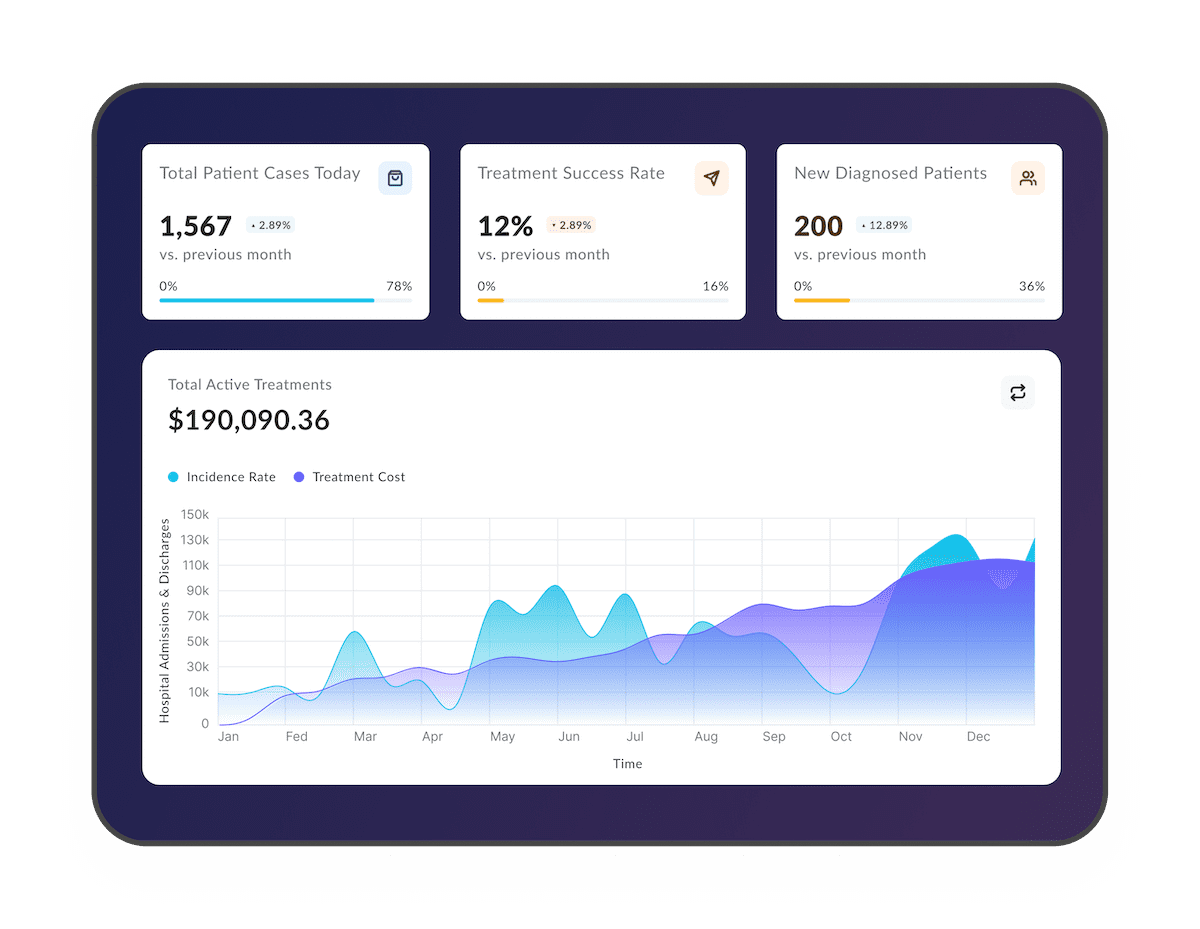
The impact has been measurable: preparation time for medical materials has decreased by 40%, data accuracy has improved with a 25% reduction in errors, and the platform has eliminated over 20 hours per week of manual CRM-related tasks.
How Relevant Software supports IDP success
When paperwork slows your business, we help turn it into reliable data. Relevant Software builds intelligent document processing solutions for various industries where errors cost time and compliance gaps create real risk.
Our approach is straightforward and reliable. We train AI models using your real documents so the system can accurately extract data from the start. The cleaned-up data flows directly into your existing tools, such as your ERP, CRM, or case management system, with no extra steps or complications.
Security is built into every part of the process. Files are encrypted, access is controlled based on user roles, and audit logs help ensure full compliance. The result is a faster and safer workflow. Teams no longer need to retype data manually and can access important information as soon as a document is received.
If you’re ready to move away from paper delays and start working with real-time insights, talk to our AI



